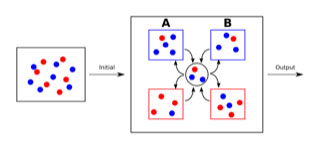The sorting of objects into groups is critical in the preparation and purification of populations of cells, crystals, beads, or droplets, necessary for research and applications in biology, chemistry and materials science. Conventionally, achieving good separation ultimately requires that the objects are considered one by one, which can be both slow and expensive, and unsuccessful in scenarios where a rapid improvement in purity is required. Here, rather than sorting individual objects, we sort the objects in ensembles, via a set of registers which are then in turn sorted into a second symmetric set of registers in a lossless manner. By repeating this process, we can arrive at high sorting purity with a low set of constraints.

Figure: Scheme of the ensemble sorter. The sorter consists of four registers, one blue and one red for both A and B. Also shown is the measurement area in the middle, which contains an ensemble to be evaluated before the sorting decision is made. Arrows indicate input to the measurement area, and output to the corresponding registers.
We demonstrate our method on various levels of scale: through in silico simulation, in a macroscopic beads-and-water system, and in an in-house designed and fabricated microfluidic droplet system. An initial population containing a mixture of two types of object is introduced to the system and fed into one of four registers; a small group, or ensemble, of the objects is then sent into a central module for viewing and decision-making. Here, if the majority in the ensemble is of one type it is sent to one register, and if the majority is of the other type, it is sent to the opposing register. If the ensemble contains equal numbers of both types, the decision of where to send it is random. Once one cycle is complete, the process is repeated in the opposite direction, and this entire process is repeated iteratively until the desired purity level is achieved.
This process was demonstrated to be successful in a variety of scenarios (various population numbers, ensemble sizes, and error levels) using in silico simulation, and then further with our macroscopic and microfluidic systems. Our experimental systems were robust to variations in population size and were in fact most effective in conditions of variable ensemble size. The microfluidic system was capable of sorting red and blue droplets at starting ratios of 1:1 and 1:99 to an extent comparable to the corresponding simulation. The microfluidic sorting process was controlled using in-house developed LabVIEW software, integrated with syringe pumps, pressure-actuated valves and real-time image processing.
Our system allows the user to adapt and refine sorting criteria in real-time, even when starting with a population of dynamic and heterogeneous objects. Our microfluidic design allows for the separation of a range of population sizes, and could be easily modified to accommodate experimental variations. In addition, we have implemented a tuneable sorting decision algorithm to efficiently enrich a minority population at a range of starting values. Our microfluidic device fabrication materials and hardware setup are relatively low-cost (compared to, e.g. a FACS setup), easily available, and interchangeable. Our image recognition/sorting criteria are not limited to colourimetric detection, but rather could incorporate other visual or physical effects on micron-scale objects. Given its iterative nature, this system could be used to sort populations of heterogeneous, dynamic objects whose properties are directly influenced by their neighbours. By utilising ensemble sorting, many avenues of research stand to be expanded and current work should be made easier with implementation of our method.
Reference
Approach to classify, separate, and enrich objects in groups using ensemble sorting. 2018. R Turk-MacLeod, A Henson, M Rodriguez-Garcia, GM Gibson, G Aragon Camarasa, D Caramelli, MJ Padgett, and L Cronin. Proceedings of the National Academy of Sciences of the USA 115 (22), 5681-5685.


































